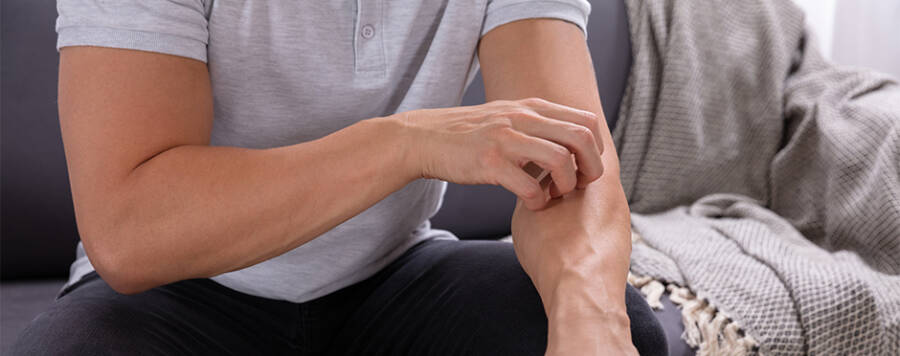It is five minutes past the last bell of the high school day. The athletic trainer is hustling around a packed athletic training room and athletes are rushing in to transition from school to practice, and then it happens; an athlete asks the athletic trainer the dreaded question:
“Do you know what this is?”
Skin diseases can be a difficult issue for athletes. By the time symptoms show up, the condition may have already been shared with half of the team. Knowing how to correctly identify, treat and prevent skin diseases can make a huge difference when working with a scenario as mentioned above.
Commonly, there are three different types of skin diseases that show up in athletes, which include viruses, bacterial and fungal infections. While these conditions can appear in any sport, they frequently occur during wrestling season. All three must be treated with medical intervention to control the infection and prevent spreading. The following list breaks down the different infections, how to spot them and treatment options.
Viral Infections
Herpes gladiatorum, also known as mat herpes, appears as painful sores with yellow/red blisters. This condition most commonly affects one side of the face/head. Some precursors to lesions showing include tenderness and swelling in the lymph nodes surrounding the neck and at the base of the skull.
Unfortunately, once an athlete contracts herpes, they have it for life. They may often find outbreaks happen during emotional or physical stress. Medications prescribed by a physician may help manage outbreaks. Athletes should not wrestle until they are on medication and released by their treating physician. Once infected, athletes should consult with their physician to see if taking a once daily suppression dose is appropriate to prevent flare ups and accidental spreading of the virus.
Bacterial Infections
Staphylococcus aureus is one of the major types of bacterial infections seen in wrestling. It is responsible for multiple forms of skin infections, such as impetigo, boils and cellulitis. The two most common bacterial infections found in wrestling are MRSA (a staph infection immune to certain medications) and impetigo.
MRSA often appears as a large boil or pimple and is accompanied by redness, soreness and swelling. Oftentimes athletes may not recognize a MRSA infection because it’s similar in appearance to a pimple. Other symptoms that often accompany a MRSA infection include a sore throat, extreme tenderness with pressure on the lesion and aggressive expansion of inflammation. It is important for affected athletes to see their physician as soon as possible to have a culture taken and begin appropriate antibiotic treatment. Delay in treatment can have potentially serious health consequences. Athletes with MRSA should not return to practice or conditioning activities until cleared by their physician.
Impetigo first appears as small red bumps and then shifts to yellow fluid filled sacs. These lesions tend to weep and often form scabbing. Athletes should not be allowed to cover active infections with tape or bandages and participate in sports until 36-48 hours after beginning treatment. Topical antibacterial medication usually helps clear these infections, but the athlete should be referred to their physician for definitive diagnosis.
Fungal Infections
Ringworm can appear anywhere on the body. It thrives in warm and moist environments and is usually contracted from head gear, mats and skin-to-skin contact. It appears as a reddish/brown, raised and itchy patch of skin that forms a ring. Typically ringworm can be treated with over-the-counter topical antifungal medication if the infection is in one spot. However, if the infection is dispersed in different areas of the body, the athlete should make an appointment with their physician to see if an oral medication is appropriate. It is important to note that it may take several weeks for the fungus to disappear, but the athlete may participate if the infection is covered and has been cleared by their physician. Athlete should be on medication for at least 72 hours before resuming full activity.
Infection Prevention
The number one way to minimize the risk of skin diseases is good personal hygiene. Athletes should clean all equipment and wash all clothing after each use. That means no re-wearing of practice clothing, not leaving wet or damp sportswear in lockers or gym bags, wiping down headgear with antibacterial wipes, and washing uniforms. Dry towels on high heat and all sportswear, including shoes, as directed by the manufacturer.
High school wrestling teams should also have a strict regimen of cleaning the mats before and after each practice with an approved mat disinfectant. After activity, athletes should shower with an antibacterial/antiviral soap as soon as possible. If an athlete sustains an abrasion or laceration during a sporting activity, receiving the appropriate care by their certified Athletico athletic trainer may greatly reduce the amount of time missed due to infection or injury.
Learn more about Athletico’s Athletic Training Coverage by clicking the button below.
The Athletico blog is an educational resource written by Athletico employees. Athletico bloggers are licensed professionals who abide by the code of ethics outlined by their respective professional associations. The content published in blog posts represents the opinion of the individual author based on their expertise and experience. The content provided in this blog is for informational purposes only, does not constitute medical advice and should not be relied on for making personal health decisions.

 width="900"
height="356"
>
width="900"
height="356"
>
